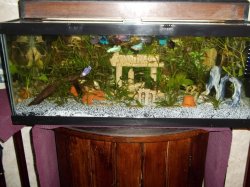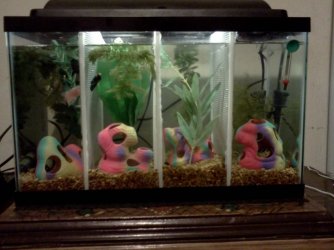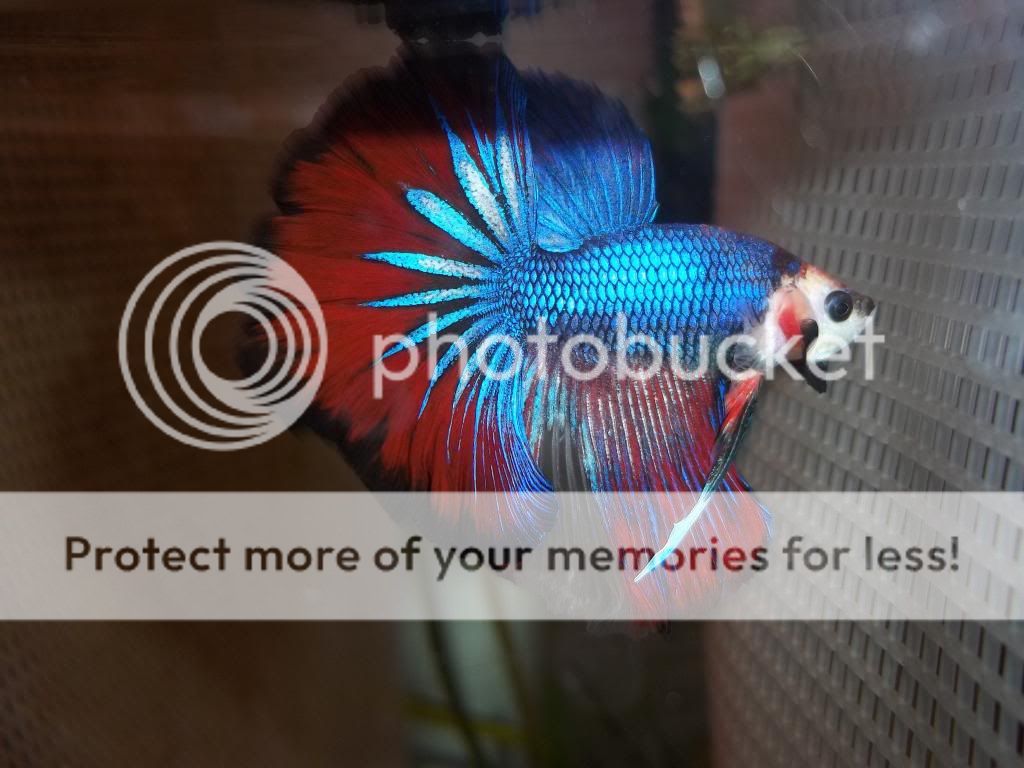
Marble Rosetail OHM
Species: Betta (pronounced bet-uh), also known as the Siamese or Thai fighting fish.
Scientific Name: Betta splendens (although the domesticated versions are a result of breeding wild betta splenden complex members together)
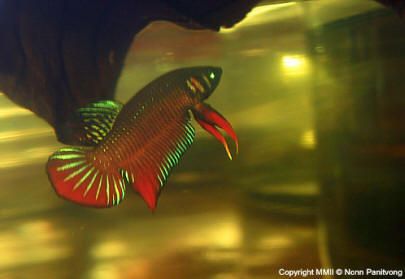
Wild Betta Splendens
Lifespan: 2 - 10 years, with 3 being average.
Description: Bettas are a freshwater tropical aquarium fish native to Thailand. They are labyrinth breathers, meaning that they are adapted to take oxygen from the atmosphere as well as from the water. They must be able to have access to the surface of the water or they will drown. The domestic betta is a colorful fish with many different fin types, from the short-finned plakat to the huge half-circle fins of the halfmoon.
Size: 6 cm (2.3 inches) standard and 7.62 cm+ (3 inches +) for giants
Temperament: Extremely aggressive to members of its own species, they will fight to the death.
At no point should two male bettas be kept together.
At no point should a male and female betta be kept together. *
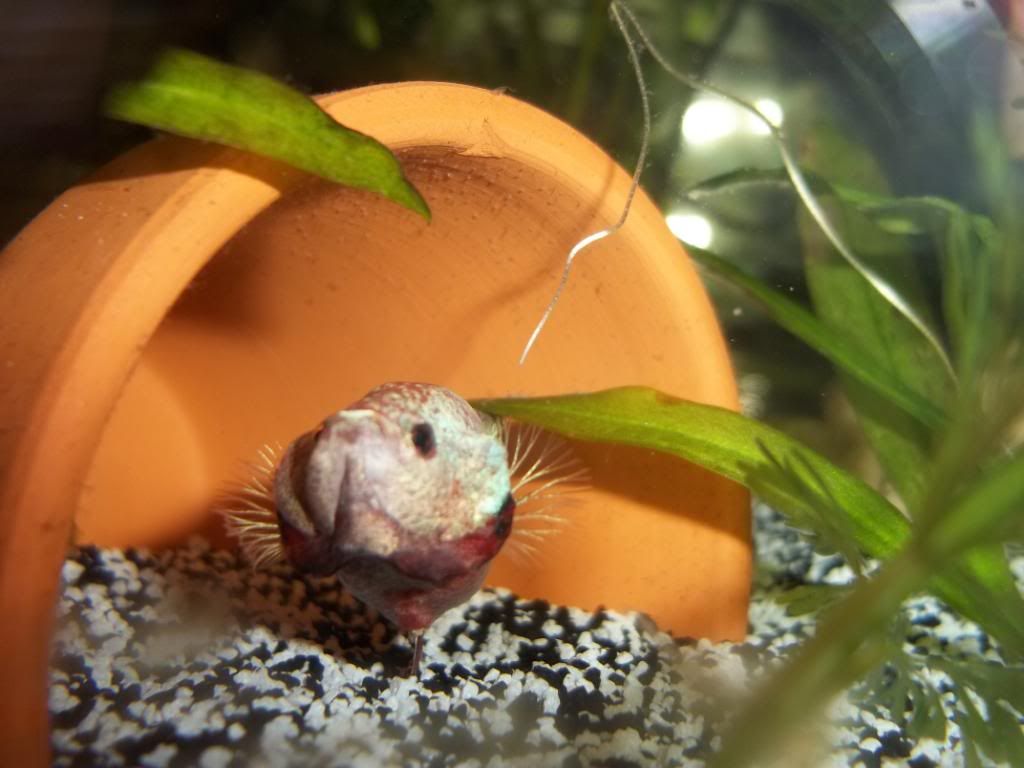
Female Betta Flaring
Bettas are semi-aggressive to other fish, and are suitable as tankmates for only a limited variety of fish species. Female bettas also are safest kept one to a tank, although with care, diligence and experience, sororities (multiple females in one tank) are possible.
Bettas are territorial, solitary fish, and do not get lonely. They are perfectly happy -- and actually prefer -- to live alone in their tank.
* To breed bettas, they must be carefully conditioned, and only put together for spawning. Please do not attempt to breed your bettas without doing the proper research. A male and female betta will kill each other unless properly conditioned!

Rice Paddies in Thailand
Housing:
Size: 2.5 gallons is a great starting point for a new betta keeper. 5 gallon tanks and above are easy to heat, easy to filter which means they need to be cleaned much less often. Contrary to popular belief, there is no minimum or maximum size tank. Bettas kept in larger tanks tend to be less prone to problems such as ammonia burn, bacterial infections, and obesity.
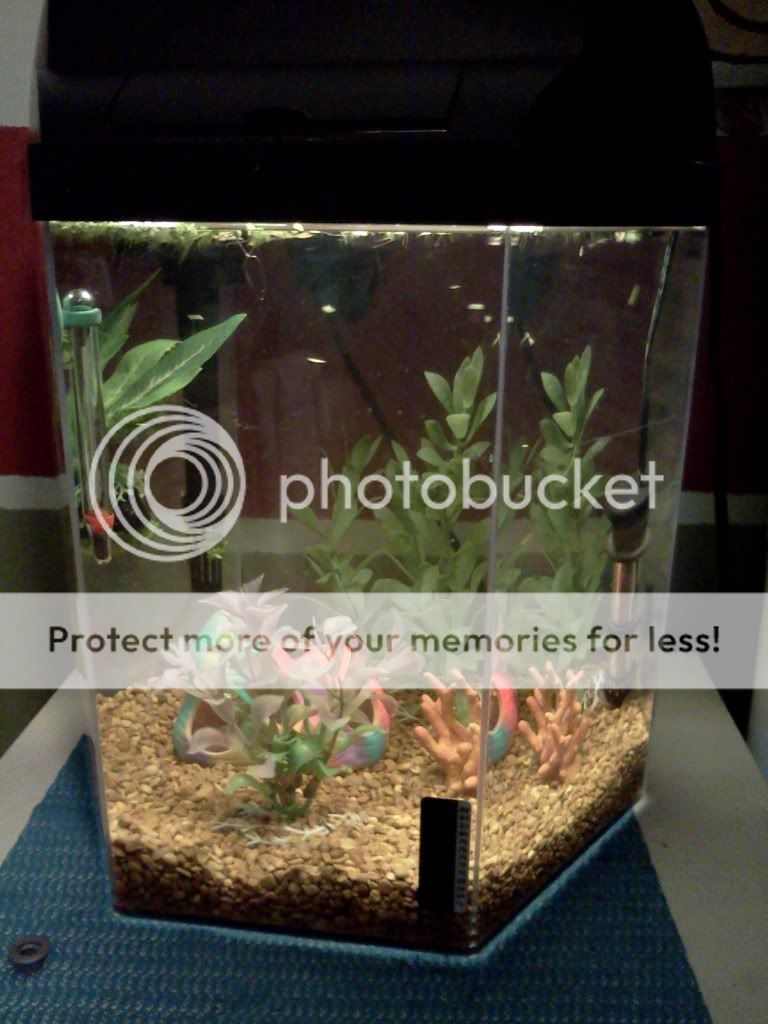
5 gallon acrylic tank perfect for a betta
Type: Acrylic or glass aquariums are both appropriate for bettas. Acrylic are lighter and easier to manuever for 100% water changes and thorough cleaning. Bettas can also be kept in fish bowls and alternative containers such as Rubbermaid storage bins, provided they are large enough.
The betta's tank must be fully covered with a hood or other lid, as bettas are jumpers. Plastic needlepoint canvas(sold at craft stores) and cling wrap are both great for creating lids or covering holes in existing hoods.
Water: In most cases, tap water is appropriate for bettas, but it should be treated with water conditioner and dechlorinator. This removes chlorine and chloramine and also neutralizes heavy metals, all of which will kill your fish. There are many good brands of water conditioner that work nearly instantly, such as Prime.
pH and Hardness: Bettas are soft water fish, and prefer a pH of neutral (7.0) or slightly acidic. They can adapt to a higher pH, as long as it is stable. It is inadvisable to use chemicals to alter the pH, which can cause dangerous fluctuations. A high pH or hard water will cause fins to curl, particularly in crowntails(this is purely cosmetic and not a health problem), which are particularly sensitive to inappropriate water parameters. Indian almond leaf (IAL) or blackwater extract (BWE) can help lower the pH naturally.
Temperature: 76F to 82F(24.4C-27.8C)
Bettas are tropical fish that need warm water. A steady temperature is important -- fluctuations can kill your fish. Water temperature should be monitored with a submersible thermometer (thermometers that stick on the outside of the tank are not accurate enough). Temperatures that are too low will result in a compromised immune system leading to susceptibility to parasites and bacterial infections, slowed metabolism leading to digestive problems and listlessness, and other health problems.
Tanks that are 2.5 gallons and higher are best heated with submersible, adjustable aquarium heaters. Because they work on a thermostat, they will keep the water temperature stable despite changes in ambient room temperature. Because they are adjustable, it is easy to adjust the temperature when treating illnesses. A 25 watt is sufficient to heat a 2.5 or 5 gallon tank. 50 watts are recommended for 10 gallon tanks.
25 watt adjustable heaters are safe to use in tanks under 2.5 gallons if they fit in the tank and are submerged to the minimum water level indicated by the heater. For tanks from one gallon to 2.5 gallons, submersible 7.5 watt pad heaters will raise the temperature a few degrees. However, water temperature should be monitored carefully. Because they are not adjustable and do not work on a thermostat, temperature in the tank may fluctuate with room temperature, so care should be taken that ambient temperature is stable. If your room temperature is too cold, these non-adjustable heaters will not be sufficient. Temperatures in houses often drop at night, when people are not awake and monitoring their tank's temperature. Air conditioning and heating will also cause temperature fluctuations. These are very dangerous for bettas which do not have a heater with a thermostat. Reptile heating tape is also a nice option for tanks up to 2 gallons.

Rice Paddies in Thailand
Filtering and Aeration: Because bettas are anabantoids, or labyrinth breathers, filtration and aeration are not required, as they are for most fish. Bettas come from stagnant, or very slow moving, very warm water in the wild, and have adapted to take oxygen from the atmosphere at the surface of the water. This is why bettas can survive in such small tanks without filters.
However, there is a great deal of debate over whether bettas are better off in unfiltered tanks with 100% water changes, or filtered, cycled tanks
If you choose to filter your tank, you should cycle the tank first. Unless you cycle the tank, you must still do frequent water changes until the tank does cycle. Fish-less cycling is advised if at all possible, as it is kindest on the fish and safest. After you cycle, you will need to change a percentage of the water once a week, in order to keep the nitrates low. Cycling is easier in tanks five gallons or larger. In tanks under five gallons, it is difficult to keep the cycle stable, and water parameters must be carefully monitored.
Because bettas are from still water and have such long fins, a strong filter current can be stressful for them, and the intake can even damage their fins. You may need to build a baffle to diffuse the current. Floating plants (real or silk) are also helpful in slowing down the current.

Natural Habitat
Even if you choose not to aerate your tank, it is a good idea to have an air pump with tubing and airstone on hand to create a bubbler for your betta in times of illness. Many medications leach oxygen from the water, and a sick betta's gills may be compromised. Because the current from a bubbler may be too much for a betta, it is advisable to purchase a gang valve to reduce the air flow, tie knots in the tubing, or to crimp the tube with some kind of clip.
Decor: Bettas come from water that has many plants growing in it in the wild, so they enjoy having decorations to explore. Betta tanks should at least have a couple silk or live plants, and an arch, cave, or piece of driftwood to swim through.
Substrate is not necessary in uncycled betta tanks and is used for purely aesthetic reasons. Aquarium gravel, river rocks, sand, or marbles are all appropriate for betta tanks. During times of illness, it is advisable to keep their tanks bare-bottomed so that you can monitor their feces for quantity, color, and consistency. Keeping the tank bare also makes the tank easier to clean.
Betta fins are very delicate, and plastic plants can tear and shred their long fins. Only silk and live plants are appropriate for bettas. To test whether a fake plant is safe for the betta, dragging a piece of pantyhose over the surface can tell you if any parts are sharp or will catch fins. A file or sandpaper can be used to smooth any bumps or sharp parts on the plastic parts of silk plants.
Live plants are extremely beneficial. Not only do they look great and provide interest to the aquarium for you and your betta, they also help keep water parameters stable and reduce toxins in the water. Some great plants for the betta aquarium are Java moss (Vesicularia dubyana), Java fern (Microsorum pteropus) and Anubias nana. All three do well in the low-light, high temperature conditions of a betta tank. They do not like to be planted in substrate, and therefore can do quite well with the 100% water changes, and gently rinsed each time. They can be lightly anchored in the gravel, left to float, or tied to a piece of driftwood or rock with fishing line.
Cleaning and Maintenance: Betta tanks, no matter their size, require regular cleaning. In an uncycled betta tank, one must do frequent water changes. The frequency and amount of water changes depends on the size of the tank with smaller tanks needing water changes more frequently than larger tanks.
In a properly cleaned betta tank, ammonia and nitrite should both be 0 parts per million (ppm) with nitrates being as low as possible.
Cleaning Schedule by Tank Size (for uncycled tanks)
1 gallon -- 100% water change every 2 days
2.5 gallon -- 100% water change every 4 to 5 days
5 gallon -- 100% water change once every 7 days
2.5+ gallons – 100% water changes are best done in smaller more frequent amounts. Example – 2.5 gallon receiving a water change every 2 days of 50% to equal 100% in 4 days.
(In a large, cycled tank [established, not currently cycling] you should change roughly 25% of the water weekly using a gravel vacuum, and test your water parameters often; ammonia and nitrite should be 0 ppm, while nitrate should be kept at less than 20 ppm.)
Diet: Bettas are carnivorous. A varied diet is important. A combination of pellets, frozen and live food is best for your betta. A betta's stomach is smaller than its eye. It is important not overfeed your betta, as this can lead to constipation, swim bladder disorder, obesity and fouled water. Most bettas should be fed small amounts two times per day.
Frozen foods can be offered instead of pellets some evenings. Frozen bloodworms, brine shrimp, tubifex worms, mysis shrimp, and daphnia are all popular options. Thaw a small amount (a couple worms is plenty, remember how small bettas stomachs are) in dechlorinated or tank water, and drop it into the tank, or offer it with an eyedropper. Bettas will quickly learn to associate the eyedropper with food! Live foods such as wingless fruit flies, pinhead crickets, and blackworms can also be offered to your betta. Live foods should be treated with care and are best bought from a store or fellow fish keeper if you don't culture your own -- wild insects may be carrying disease or contaminated with pesticides.
Flakes and freeze-dried foods, though popular, are not recommended. They are dry, which is unnatural in a carnivore's diet, airy, and can possibly swell with liquid inside the betta's stomach, and can lead to swim bladder disorder and constipation. Freeze-dried bloodworms are often fed as the exclusive diet to bettas in chain pet stores. This diet is nutritionally inadequate and dangerous.
Behavior: Bettas are wonderful fish with a lot of personality. Betta personality varies. Some bettas are shy and easily stressed. Others are aggressive and outgoing.
Male bettas blow bubblenests. Some do so more than others. It is not a sign of happiness or health whether the betta blows a bubblenest or not. It is a sign that the male betta is sexually mature and able to breed. Some blow nests all the time and others may never blow one.
Bettas are extremely aggressive toward their own species. Male bettas should not be kept with another betta, ever. They will fight to the death.
Female bettas can only be kept with other female bettas if a variety of conditions are met. Bettas, including female bettas, are solitary, territorial fish, which are more at home in individual tanks. If housed together, females must be kept in groups of four or more in an appropriately sized tank (ten gallons or larger) that has a lot of plants (silk or live) and a lot of hiding places. Keeping more than four female bettas together helps diffuse the aggression. A sorority set-up is not natural for the bettas, though convenient for the keepers, and they must be monitored closely. Some female bettas are just too aggressive to be kept in a sorority, even if the suggested guidelines are followed. It is important to keep an eye on such a set-up to make sure the bettas are safe and happy. It is recommended that only experienced betta keepers attempt a sorority.
Bettas are an addictive fish to keep and most people find themselves acquiring multiple fish. Since bettas are best kept solitary, it can become difficult to keep multiple fish without having lots of tanks. A option in these situations are divided tanks. A divided tank allows more than one betta to live in the same amount of water but still be separate for safety reasons. Divided tanks also offer a better ability to heat and filter a tank since they are normally larger tanks.
20 gallon long betta sorority and 10 gallon tank divided into 4 equal sections.


